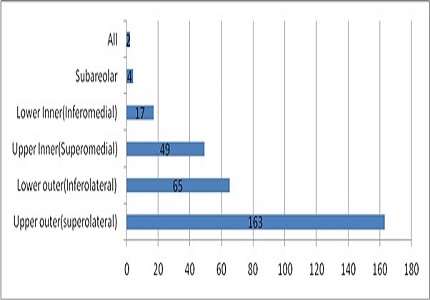The diagnostic utility of FNAC in palpable lesions of breast at a tertiary care centre
Abstract
Background: Breast lumps constitute a significant proportion of surgical cases in both developed and developing countries. Fine Needle Aspiration Cytology (FNAC) is a simple, minimally invasive, cost effective, outpatient based and a rapid diagnostic method for breast lesions. The aim of the present study was to study the cytological spectrum, cytohistological correlation and diagnostic accuracy of aspiration cytology (FNAC) in palpable breast lesions. Material and
Methods: This was a prospective study done in the department of Pathology, L.N. medical college, Bhopal, India from January 2016 to December 2016. FNAC of 300 cases of palpable breast lesions were done and reported by expert pathologist. The histopathological specimen when available were reported by other pathologist without prior knowledge. Sensitivity, specificity and accuracy of FNA diagnosis were then analyzed.
Results: A total of 300 cases of breast lesion were diagnosed on FNA, out of them histopathological correlation was available for 150 cases. Benign breast lesions are more common in younger patients in 11-30 age group and Malignant breast lesion are more common in old age group patients of 41-60 yrs age group. Benign breast lesions were found in 215 cases (71.66%); among which fibroadenoma (41%) was the commonest lesion observed. Malignancy was observed in 63 cases (21%); among them, Ductal carcinoma was the predominant lesion (17.66%). The sensitivity, specificity and diagnostic accuracy of FNAC for malignant lesion is found to be 98.3%, 98.9% and 98.7% respectively.
Conclusion: FNAC is an effective and valid tool as first line diagnostic modality in preoperative diagnosis of malignant and benign breast lesions.
Downloads
References
Vaidyanathan L, Barnard K, Elnicki DM. Benign breast disease: when to treat, when to reassure, when to refer. Cleve Clin J Med. 2002 May;69(5):425-32.
Guray M, Sahin AA. Benign breast diseases: classification, diagnosis, and management. Oncologist. 2006 May;11(5):435-49.
Kocjan G, Bourgain C, Fassina A, Hagmar B, Herbert A, Kapila K, Kardum-Skelin I, Kloboves-Prevodnik V, Krishnamurthy S, Koutselini H, Majak B, Olszewski W, Onal B, Pohar-Marinsek Z, Shabalova I, Smith J, Tani E, Vielh P, Wiener H, Schenck U, Schmitt F. The role of breast FNAC in diagnosis and clinical management: a survey of current practice. Cytopathology. 2008 Oct;19(5):271-8. doi: https://doi.org/10.1111/j.1365-2303.2008.00610.x.
Hindle WH, Payne PA, Pan EY. The use of fine-needle aspiration in the evaluation of persistent palpable dominant breast masses. Am J Obstet Gynecol. 1993 Jun;168(6 Pt 1):1814-8; discussion 1818-9.
Bhargava V, Jain M, Agarwal K, Thomas S, Singh S. Critical appraisal of cytological nuclear grading in carcinoma of breast and its correlation with ER/PR expression. J Cytol. 2008 Mar;25(1):58–61.doi: http://www.jcytol.org/text.asp?2008/25/2/58/42445.
Joshi A, Maimoon S. Limitations of fine needle aspiration cytology in subtyping breast malignancies- A report of three cases. J Cytol. 2007 Mar16;24(4):203–6. Doi: http://www.jcytol.org/text.asp?2007/24/4/203/41899.
Guidelines for non-operative diagnostic procedures and reporting in breast cancer screening Non-operative Diagnosis Subgroup of the National Coordinating Group for Breast Screening Pathology NHSBSP Publication No 50 2001 June:50(2):20-23.
Böcker W, Moll R, Poremba C, Holland R, Van Diest PJ, Dervan P, Bürger H, Wai D, Ina Diallo R, Brandt B, Herbst H, Schmidt A, Lerch MM, Buchwallow IB. Common adult stem cells in the human breast give rise to glandular and myoepithelial cell lineages: a new cell biological concept. Lab Invest. 2002 Jun;82(6):737-46.
Wiseman BS, Werb Z. Stromal effects on mammary gland development and breast cancer. Science. 2002 May 10;296(5570):1046-9.
Litherland JC. Should fine needle aspiration cytology in breast assessment be abandoned? Clin Radiol. 2002 Feb;57(2):81-4.
Khemka A, Chakrabarti N, Shah S and Patel V. Palpable breast lumps, fine-needle aspiration cytology versus histopathology:a correlation of diagnostic accuracy. The internet journal of surgery.2009 Dec 1; 18(1): 1-7.
Rocha PD, Nadkarni NS, Menezes S. Fine needle aspiration biopsy of breast lesions and histopathologic correlation. An analysis of 837 cases in four years. Acta Cytol. 1997 May-Jun;41(3):705-12.
Ganiat O, Omoniyi-Esan G, Osasan S, Titiloye N, Olasode B. Cytopathological review of breast lesions in Ile-Ife Nigeria. The Internet J. of Third World Med.2008 Jan;8(1):10-25.
Hussain MT. Comparison of fine needle aspiration cytology with excision biopsy of breast lump. J Coll Physicians Surg Pak. 2005 Apr;15(4):211-4.
Meena SP, Hemrajani DK, Joshi N. A comparative and evaluative study of cytological and histological grading system profile in malignant neoplasm of breast An important prognostic factor. Indian J PatholMicrobiol. 2006 Apr;49(2):199–202.
Yeoh GP, Chan KW. Fine needle aspiration of breast masses: an analysis of 1533 cases in private practice. Hong Kong Med J. 1998 Sep;4(3):283-288.
Malik R, Bharadwaj VK. Breast lesions in young females--a 20-year study for significance of early recognition. Indian J Pathol Microbiol. 2003 Oct;46(4):559-62.
Iyer SP; Epidemiology of Benign Breast Diseases in females of child bearing age group. Bombay Hospital Jr., 2000 Jan; 42(1): 141-146.
Mayun AA, Pindija VH; Pattern of histopathological diagnosis of breast lesion in Gombe, Nigeria. Nigerian J Med., 2008 Apr;17(2): 159-162.
Aslam S, Hameed S, Afzal T, Hussain A. Correlation of FNAC and HistologicalDiagnosis in the Evaluation of Breast Lumps. JUMDC 2012 Jul-Dec; 3(2): 1-7.
REDDY DG, REDDY CR. Carcinoma of the breast, its incidence and histological variants among South Indians. Indian J Med Sci. 1958 Apr;12(4):228-34.
Clegg-Lamptey J, Hodasi W. A study of breast cancer in korlebu teaching hospital: Assessing the impact of health education. Ghana Med J. 2007 Jun;41(2):72–7.
Zuk JA, Maudsley G, Zakhour HD. Rapid reporting on fine needle aspiration of breast lumps in outpatients. J Clin Pathol. 1989 Sep;42(9):906-11.
Chaiwun B, Thorner P. Fine needle aspiration for evaluation of breast masses. Curr Opin Obstet Gynecol. 2007 Feb;19(1):48-55.
Ariga R, Bloom K, Reddy VB, Kluskens L, Francescatti D, Dowlat K, Siziopikou P, Gattuso P. Fine-needle aspiration of clinically suspicious palpable breast masses with histopathologic correlation. Am J Surg. 2002 Nov;184(5):410-3.
Singh K, Sharma S, Dubey VK, Sharma PR.Role of FNAC in diagnosis of breast lumps. JK Science.2001 July-Sept; 3(3):126-128.
Parker SH, Stavros AT, Dennis MA. Needle biopsy techniques. Radiol Clin North Am. 1995 Nov;33(6):1171-86.



 OAI - Open Archives Initiative
OAI - Open Archives Initiative


